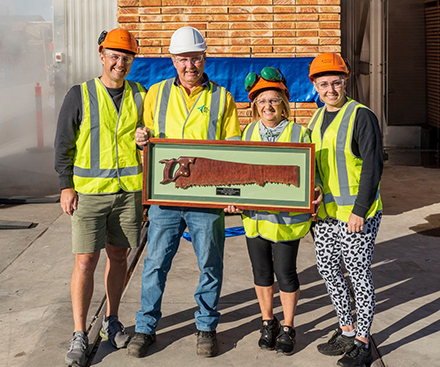Roger Davis started working at the Jubilee Sawmill site in 1971. This year, after a long and dedicated career, Roger will transition into a well-earned retirement. He shared a little bit of his story… Source: Roger Davis, Jubilee Mill Kilns Manager
I started at the mill as a timber stacker on 16 March 1971. I was 15 and it was only two weeks after arriving from England with my family.
My first pay packet was $16.
These days safety is the highest priority, but back then health and safety were almost non-existent.
There were no inductions or mandatory protection like eye and ear protection. Timber stacking and wrapping was all done by hand, even logs were manually rolled onto the log deck.
The first stress grader was fed manually, obviously at much slower feed speeds that the current high-speed line.
My father and brother both worked here when I started, and my late father was kilns manager in the early ‘70s. I often helped out on weekends at the kilns.
There were many families that worked at the mill Mum, Dad and often their children, including a lot of migrant families and so many different cultures.
I worked my way up from timber stacker to forklift driver then machinist operating any moulder/planer or machines in both mill A and B.
I was promoted to leading hand in late ‘70s and worked in all areas of the dry mill.
Also, in the late ‘70s the mill had a cricket team in the local competition made from players from all sections – some had never played before. We ended up with two teams in C and D grade, and I was lucky enough to captain the side to a C grade premiership.
In 1983, Dry Mill B was transformed into a high-speed moulding line when the Waco moulder and associated equipment was installed, I was the appointed shift team leader and later shift supervisor.
At the time, the Waco moulder was one of the most efficient high-speed moulders in Australia, able to run at speeds up to 180 metres per minute and producing high quality profiles such as match lining, flooring and decking products.
In the 90s I managed Dry mill A and B at different times, then in late 1990 I was offered the position as kilns manager, so I worked over Easter that year to do a crash course in kiln drying.
At the time we still had old limestone kilns from the late ‘50s and four newly installed high temp Windsor kilns.
In 2009, four new Windsor High temp kilns were installed. These kilns could dry more than the 22 older kilns and were much safer to operate. All old kilns were demolished making way for pack storage from Green Mill.
The four Windsor kilns have proven to be the most efficient batch kilns Winsor have in Australia and have dried over 4 million cubic meters of timber for our dry mills to process.
Now it’s exciting to see the new CDK operational and already producing quality kiln dried timber.
I have seen many changes to equipment and technology over the years.
I’ve worked with so many good people over the years and would like to thank them for their friendship and support, that without I would not have made it to 50 years.






